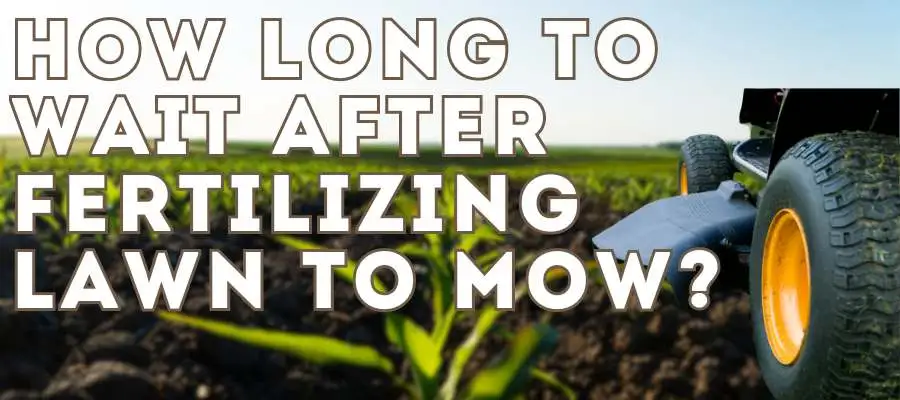Fertilizing your lawn is a crucial step in maintaining a healthy and attractive yard. Fertilizers provide essential nutrients to your grass, ensuring it remains green and robust.
However, to maximize the benefits of fertilization, it’s important to understand the optimal waiting period before mowing your lawn.
This guide explores why timing matters, How Long to Wait After Fertilizing Lawn to Mow, and best practices for ensuring your lawn remains in top shape.
Why Waiting to Mow is Important

Nutrient Absorption
The waiting period after fertilization is crucial for allowing nutrients to be effectively absorbed into the soil. Here’s why:
Nutrient Penetration
Fertilizers need time to dissolve and infiltrate the soil. This process allows nutrients to reach the grass roots, where they are taken up and utilized. Mowing too soon can prevent this vital step from occurring, reducing the effectiveness of the fertilizer application.
Enhanced Effectiveness
Waiting ensures that the fertilizer has enough time to be absorbed by the grass. This improves nutrient availability and promotes healthier, more robust growth. Without this waiting period, the fertilizer may not be as effective, and you may not see the full benefits of your application.
Prevention of Fertilizer Loss
Mowing immediately after applying fertilizer can have several detrimental effects:
Disruption of Fertilizer Application
Lawn mowers, especially those with grass catchers, can remove the fertilizer from the grass before it has had a chance to be absorbed into the soil. This results in the loss of valuable nutrients and can lead to uneven fertilization.
Uneven Application
If you mow too soon, the fertilizer may be disturbed and spread unevenly across your lawn. This can cause patches of over-fertilization or under-fertilization, leading to uneven grass growth and appearance.

By allowing the fertilizer to settle and be absorbed into the soil, you ensure that it performs its intended function and supports your lawn’s health. The waiting period helps maximize the benefits of fertilization and promotes a more uniform and attractive lawn.
How Long to Wait After Fertilizing Lawn to Mow?
Granular Fertilizer
Granular fertilizers are the most common type used for lawn care. They come in both quick-release and slow-release forms. Here’s how long you should wait before mowing after applying granular fertilizer:
Recommended Waiting Time: Generally, it’s advised to wait 24 to 48 hours after applying granular fertilizer before mowing. This allows the fertilizer to dissolve into the soil and be absorbed by the grass roots.
Importance of Dissolving: Granular fertilizers need to be watered in to activate. Waiting the recommended time ensures that most of the nutrients have had a chance to dissolve and penetrate the soil before mowing, preventing nutrient loss.
Liquid or Spray-on Fertilizer
Liquid or spray-on fertilizers are absorbed quickly by the grass. However, they also require a waiting period before mowing:
Recommended Waiting Time: For liquid fertilizers, it’s best to wait 2 to 4 hours or until the grass is completely dry before mowing. This ensures that the fertilizer has had enough time to be absorbed by the grass blades and roots.
Specific Considerations: Liquid fertilizers can be quickly washed away if it rains shortly after application. If you’re applying liquid fertilizer, monitor the weather forecast and try to apply it on a dry day.
Example: If you apply a liquid fertilizer on a sunny afternoon, wait until the grass is dry and firm before mowing, usually a few hours after application.
Herbicide and Fertilizer Mixtures
Fertilizers that contain herbicides require special attention:
Application and Waiting Instructions: These mixtures are often applied after a light watering, which helps the herbicide adhere to the plant leaves. You should wait until the herbicide has dried on the leaves before mowing. This can typically take 24 hours.
Role of Light Watering: Watering after application helps the herbicide and fertilizer mix to stick to the grass, enhancing its effectiveness. However, excessive watering can dilute the fertilizer, so follow product instructions carefully.
Example: If you apply a herbicide-fertilizer mix early in the morning, wait until the following morning to mow, ensuring the herbicide has dried and the fertilizer has had time to activate.
Common Mistakes to Avoid
Mowing Too Soon
Mowing too soon after applying fertilizer can lead to several issues:
Nutrient Loss: Mowing too early can remove the fertilizer before it has been absorbed into the soil, reducing its effectiveness.
Uneven Growth: Immediate mowing can disturb the even distribution of fertilizer, leading to uneven grass growth.
Ignoring Application Instructions
Each fertilizer product comes with specific application instructions. Ignoring these can lead to suboptimal results:
Product-Specific Guidelines: Follow the manufacturer’s instructions for application and waiting periods to ensure the best results.
Adjusting for Weather: Be mindful of weather conditions and adjust your fertilization and mowing schedule accordingly.
Tip: Always read and follow the instructions on the fertilizer package for the best results.
Conclusion
Understanding how long to wait after fertilizing your lawn before mowing is crucial for achieving a healthy, vibrant yard. By allowing the fertilizer to be absorbed properly, you ensure that your lawn receives the maximum benefits from the nutrients provided. Follow the recommended waiting times, prepare your lawn properly, and avoid common mistakes to keep your lawn looking its best.

